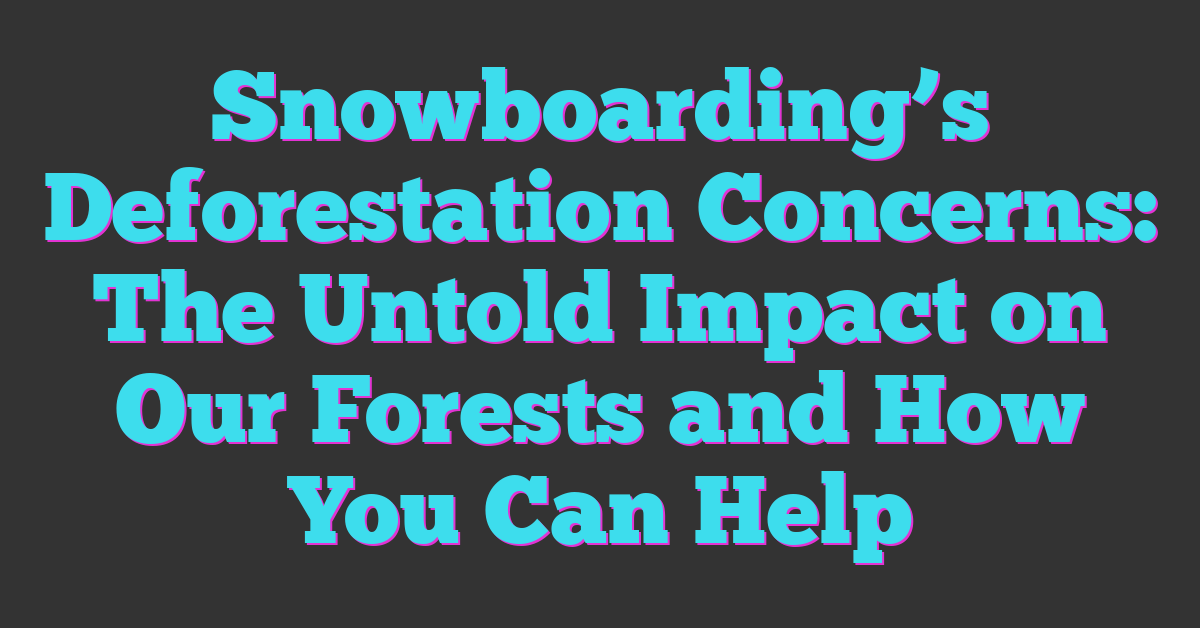Snowboarding takes you deep into nature’s winter playground, but have you ever thought about the impact it has on the environment? While it’s thrilling to carve down snowy slopes, the development of ski resorts and trails often comes at a cost to surrounding forests. Trees are cleared to create runs and infrastructure, which can disrupt local ecosystems and wildlife habitats.

If you love hitting the mountains, it’s important to understand the balance between enjoying your sport and protecting the forests that make it all possible. By learning about deforestation concerns linked to snowboarding, you can make more eco-friendly choices and support sustainable practices that help keep these winter wonderlands intact for years to come.
Understanding Snowboarding’s Deforestation Concerns
You already know how much snowboarding depends on pristine mountain landscapes. Every new run or lift often means clearing trees that serve as homes for wildlife and protect soil from erosion. When forests are cut down, local ecosystems suffer from habitat loss and disrupted natural processes, which affects more than just the terrain you ride.
You see, building resort infrastructure involves removing vegetation and compacting soil, making forests less resilient to weather changes. These changes can lead to increased runoff, harming nearby rivers and streams vital for plants and animals. Even small patches of cleared forest can fragment habitats, making it harder for wildlife to thrive.
You might ride down a freshly groomed run without realizing the work it took to open that path. Every acre cleared for snowboarding adds up, especially in popular mountain regions. Resorts often balance economic benefits against environmental impact, but you can play a role by choosing operators committed to sustainable practices.
You’ll find that many resorts now incorporate forest conservation into their planning, minimizing tree removal and restoring areas post-season. Supporting these initiatives helps ensure snowboarding stays connected to the natural beauty you love without costing the forests that make your sport possible.
Environmental Impact of Snowboarding Resorts
Snowboarding thrives on untouched mountain terrain, yet the creation of resorts affects the environment in visible ways. You’ll find that understanding these impacts helps protect the landscapes you love to ride.
Tree Removal and Habitat Disruption
Tree removal happens each time resorts create new runs or install lifts. You’ll notice that clearing trees fragments habitats, forcing wildlife like birds, deer, and small mammals to relocate. This disruption breaks important ecological corridors that animals use for food, shelter, and migration. You benefit when resorts limit clearing and prioritize preserving native forests, as it keeps wildlife populations stable and maintains the natural backdrop for your rides.
Soil Erosion and Water Quality Issues
Soil erosion increases after trees and vegetation are removed. You’ll find that exposed soil washes downhill during snowmelt, carrying sediment into rivers and streams. This runoff reduces water quality, harming aquatic life and your access to clean mountain water. Resorts with poor erosion controls can cause sediment buildup that affects fisheries and drinking water supplies downstream. You help preserve water quality when you support resorts that use erosion barriers, replant native vegetation, and design trails to reduce runoff.
Economic and Social Factors Driving Deforestation
Snowboarding thrives in mountain resorts, but expanding facilities often drives deforestation. Understanding these economic and social forces helps you see the bigger picture behind the trees that come down as slopes grow.
Expansion of Ski and Snowboard Infrastructure
Ski resorts expand lifts, runs, and lodges to meet your growing demand for fresh terrain and improved amenities. Each new lift line or run clears hundreds to thousands of trees, affecting forest cover significantly. Resorts invest millions in these developments to attract more visitors and extend their seasons. When resorts prioritize growth to boost profits, forests face ongoing pressure, and ecosystems get fragmented. However, some operators use sustainable design to limit tree removal—integrating terrain to preserve as many trees as possible while still catering to snowboarders like you.
Local Community and Tourism Pressures
Communities around ski areas rely heavily on winter tourism, so economic benefits create incentives to expand resorts. Local jobs in hospitality, retail, and guiding increase with visitor counts, reinforcing the cycle of resort development. You’ll find businesses and residents advocating for growth to support livelihoods, even as forests shrink. Sometimes, this leads to compromises where ecological concerns take a backseat to economic survival. Recognizing this balance between social needs and environmental protection helps you appreciate the complex factors behind deforestation tied to snowboarding hotspots you love.
Sustainable Practices in Snowboarding Areas
Protecting the forests you ride in keeps the mountain experience pure. Resorts and communities adopt sustainable methods to reduce deforestation’s impact while maintaining snowboarding’s thrill.
Eco-Friendly Resort Developments
Designing new runs and infrastructure with nature in mind prevents unnecessary forest loss. Resorts use precise mapping and satellite data to avoid sensitive habitats and minimize tree removal. You’ll find many places now prioritize compact vertical expansions rather than wide clearings, preserving canopy cover. Energy-efficient snowmaking systems cut water waste and reduce strain on local ecosystems. Eco-friendly buildings incorporate sustainable materials and insulation to lessen their footprint while providing comfort. Resorts also limit vehicle traffic by enhancing public transit and shuttle services, reducing pollution and protecting air quality around the slopes.
Conservation Efforts and Reforestation Projects
Restoring damaged forests supports wildlife and protects soil from erosion you’ve experienced firsthand on steep runs. Many resorts partner with environmental groups to plant native trees after each season, helping reconnect fragmented habitats. Volunteers, including passionate riders like you, often participate in these reforestation efforts. Protecting old-growth trees is another key focus since they serve as critical habitats and carbon sinks. Resorts create buffer zones where no development occurs, safeguarding these vital areas. Conservation education programs inform visitors on how to stay on marked trails and respect the natural environment, ensuring the terrain stays healthy and rideable for years.
Future Outlook for Snowboarding and Forest Conservation
You’ll find growing efforts in the snowboarding community to protect forests while keeping the stoke alive. Resorts increasingly use smart planning that limits tree removal and preserves key wildlife corridors. You can see vertical expansions that prioritize compact, less disruptive layouts over sprawling developments. Resorts investing millions in energy-efficient snowmaking systems reduce the need for clearing new runs, which helps keep mountain ecosystems intact.
You’ll notice many resorts partnering with environmental groups to plant native trees and restore areas damaged by past developments. These reforestation projects help rebuild habitats for deer, birds, and small mammals while stabilizing soil to prevent erosion. You can support resorts adopting best practices by learning about their conservation programs and choosing destinations that prioritize environmental stewardship.
You’ll observe technology advances aimed at balancing winter sports growth with forest health. Innovations like drone mapping help identify sensitive zones, enabling more informed construction and trail design decisions. You’ll also find educational initiatives at resorts, where visitors learn about local ecosystems and how to reduce their footprint on the slopes.
You’ll want to get involved by advocating for sustainable snowboarding practices in your favorite locations. Participation in community efforts improves awareness and encourages resorts to invest in forest-friendly options. You’ll feel good knowing your choices help maintain the mountain landscapes you love for many seasons to come.
Conclusion
You have the power to make a difference in preserving the forests that make snowboarding so special. By choosing resorts committed to sustainable practices and supporting conservation efforts, you help protect wildlife habitats and keep mountain ecosystems healthy.
Enjoy your time on the slopes knowing that your choices contribute to a future where snowboarding and nature thrive together. Staying informed and spreading awareness can inspire others to join in protecting these beautiful winter landscapes you love.
















